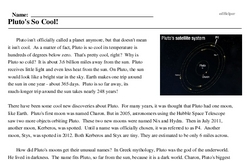Pluto's So Cool!
Pluto isn't officially called a planet anymore, but that doesn't mean it isn't cool. As a matter of fact, Pluto is so cool its temperature is hundreds of degrees below zero. That's pretty cool, right? Why is Pluto so cold? It is about 3.6 billion miles away from the sun. Pluto receives little light and even less heat from the sun. On Pluto, the sun would look like a bright star in the sky. Earth makes one trip around the sun in one year - about 365 days. Pluto is so far away, its much-longer trip around the sun takes nearly 248 years!
There have been some cool new discoveries about Pluto. For many years, it was thought that Pluto had one moon, like Earth. Pluto's first moon was named Charon. But in 2005, astronomers using the Hubble Space Telescope saw two more objects orbiting Pluto. These two new moons were named Nix and Hydra. Then in July 2011, another moon, Kerberos, was spotted. Until a name was officially chosen, it was referred to as P4. Another moon, Styx, was spotted in 2012. Both Kerberos and Styx are tiny. They are estimated to be only 6 miles across.
How did Pluto's moons get their unusual names? In Greek mythology, Pluto was the god of the underworld. He lived in darkness. The name fits Pluto, so far from the sun, because it is a dark world. Charon, Pluto's biggest moon, was named after the boatman of the underworld. It was Charon's job to carry in his boat the souls of the dead across the underworld's main river. Another moon was named Nix, after the goddess of night. Nix was Charon's mother. The moon Hydra was named after the nine-headed monster that lived in a lake near the entrance to the underworld. Maybe its nine heads go well with the ninth (although dwarf) planet? Styx is the river that formed the boundary between earth and the underworld. It is the river Charon's boat crosses. Kerberos is the beast that guards the entrance of the underworld. Its job is to prevent the dead from escaping and to keep the living from entering. Kerberos is most commonly represented as a three-headed dog (though some drawings show many more heads) with a serpent's tail, a mane of snakes, and lion's claws.




